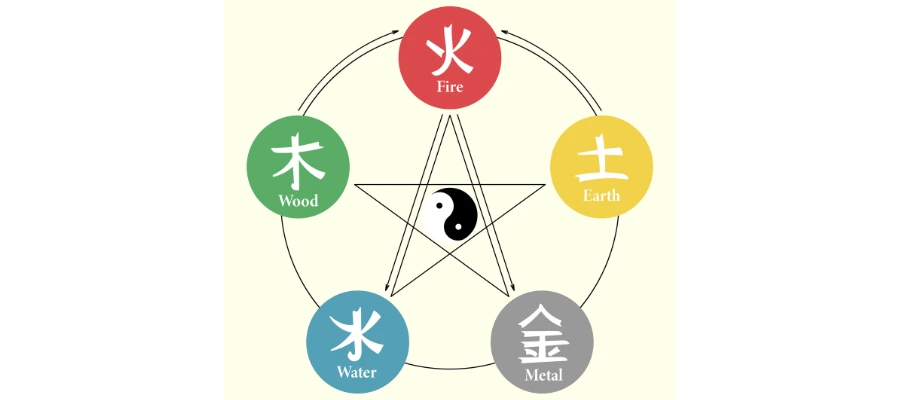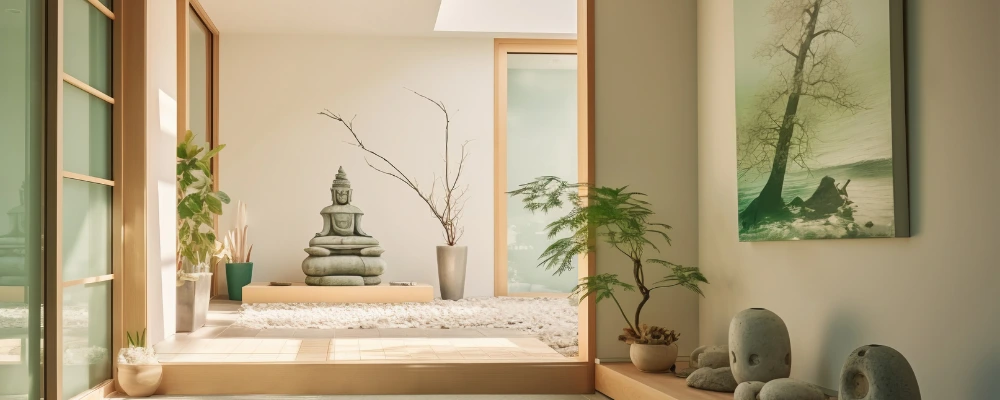While designing homes, architects take into consideration many spiritual practices that shape their clients’ beliefs. Many of these practices are rooted in ancient wisdom and culture and act as guiding principles for spatial design. One such ancient doctrine of design principles originating in China is ‘Feng Shui’, which has become popular globally today due to the harmonious philosophy that it preaches. Continue reading to understand what exactly Feng Shui is, its principles, the differences between Feng Shui and Vastu Shastra from India and learn some design tips to incorporate Feng Shui for homes.
What is Feng Shui?
Feng Shui is an ancient design philosophy originating in China and used to enhance balance and harmony in built spaces. ‘Feng’ means air and ‘shui’ means water, both of which combine to translate to ‘fluid’, referring to the fluid flow of energy through spaces. Also called ‘feng sui’, this philosophy aims to enhance the experience and lifestyle of people by harnessing positive energies in buildings. Although having ancient roots, many of its principles hold relevance even today and are major guiding factors for modern architectural and interior design.
Principles of Feng Shui
The most significant principles guiding the concept of Feng shui design are:
Chi
‘Chi’ or ‘Qi’ refers to the vital life force or energy which connects human life to the natural elements. The philosophy focuses on optimising the placement of furniture, storage elements and other interior items to enhance energy flows through a space, while avoiding the clashing of opposing energies (i.e., positive and negative).
Five Elements

According to this philosophy, five natural elements guide design:
- Earth: Depicts stability, wellness and being grounded in nature. Earthy colours like shades of yellow, brown and red are used to denote this element.
- Fire: Represents vital forces of passion, inspiration and energy in humans. Shades of orange and red, triangular or pointed shapes and bold patterns characterise this element.
- Water: Symbolises emotional and spiritual depth, abundance in wealth and connectivity with other people. Hues of black and blue, along with curvilinear and flowy shapes and forms depict this element in design.
- Wood: Represents growth, new beginnings and healing. Green and blue colour shades, along with different types of wood products and Feng shui plants signify wood in home design.
- Metal: Depicts joy, strength, beauty and precision. Colours like white, grey and black and metallic objects in home decor portray this element.
Bagua
‘Bagua’ refers to eight areas- health (tai qi), family (zhen), wealth (xun), helpful people (qian), knowledge (gen), children (dui), career (kan) and fame (li). Depicting these eight areas, Bagua maps have a central ninth portion formed by you, who acts as an anchor for all the other elements. These maps are used to create floor plans that harmonise all the elements with their energy flows. Octagonal shaped Bagua mirrors are commonly included in homes to symbolise this principle.
Commanding Position
In a Feng shui house, the room location which is not directly in front of the door, but is visible from it and is preferably against a solid wall forms the commanding position. The main objects in every room—such as the sofa in living rooms, bed in bedrooms, stove in kitchens and the desk in study rooms—must occupy the commanding position.
Feng Shui Vs Vastu
Feng shui and Vastu Shastra are both ideological beliefs used in home design. However, there are some key differences between the two, including:
| Feng Shui | Vastu Shastra | |
| Origin | Originated in China around 6,000 years ago | Originated in India around 12,000 years ago |
| Concept | Deals with creating harmony by regulating the flow of positive and negative energies in spaces. | Is a scientific philosophy based on the flow of wind, sunlight, etc. along the cardinal directions. |
| Usage | Is commonly applied to interior design and the placement of decorative/ symbolic items in rooms. | Is applied for architectural and spatial planning, optimising building orientation as well as interior design. |
| The Five Elements Used as a Basis | Fire, water, wood, metal and earth | Air, water, wind, earth and fire |
Feng Shui for Home: Design Tips for Different Rooms
Incorporating Feng Shui products and philosophies in homes can lead to peace of mind and harmonious living by regulating energy flows. Listed below are some Feng shui tips to enhance the energy flow in different spaces in your home:
Feng Shui Living Room
A living room is a space where most residents spend the majority of their time. According to Feng Shui, this space represents family time and harmony between the energies of family members. A few tips to optimise Fengshui in living rooms are:
- Living room designs must be executed such that they are close to the main entrance, but not directly facing it.
- The main sofas or seating spaces must be placed in a commanding position in the room, preferably against supporting walls at the back.
- Use organic shapes and smooth curves that promote smooth movements and avoid sharp angles that disrupt free flow.
Feng Shui Bedroom
Bedrooms symbolise peaceful living and significantly impact the physical and mental well-being of their users by regulating sleep cycles. Follow the below tips for optimising the energy flow in these spaces:
- Feng shui bed placement is based on the commanding position principle- position the bed against solid walls and not below windows or other openings.
- Use bedroom wall colour combinations that are sober and subtle to maintain a peaceful atmosphere.
- Avoid clutter and electronic appliances like televisions and computers. Include Feng shui items like plants, artwork with positive imagery and sweet fragrances.
Kitchens
Kitchens are considered to be the heart of homes and symbolise nourishment, prosperity and good health. A few tips to ensure home fengshui in kitchens are as follows:
- Place the kitchen far from the main entrance and door.
- Having the kitchen close to the dining room symbolises a free flow of nourishment through the house.
- Avoid placing fire and water elements (such as stoves and kitchen sinks) close to each other as they represent negating energies.
- Clashing energies between fire and peace can occur when the kitchen is placed above or below bedrooms and must be avoided.
Bathrooms
Bathrooms are associated with the water element, which symbolises the flow and accumulation of wealth. A bathroom can impact the flow of energies within the house and a few tips to optimise Fengshui here are:
- The Northeast direction is considered auspicious for placing bathrooms and the South direction must be avoided.
- Always keep the bathroom door closed. This can prevent the flow of negative energy into other spaces.
- Get any water leakages or defective sink taps and faucets immediately fixed as they are believed to leak away abundance and wealth.
Study Rooms/ Workspaces
A study room or home office is where productivity and creativity are vital. Feng shui here aims to maximise concentration, learning and success. Some ways to incorporate it in study rooms are:
- Place the workdesk in the commanding position, facing away from the entry door and close to windows.
- Keep sofas, armchairs and other furniture to the right side of the desk.
- Avoid clutter and use soft, neutral colours like white, beige and yellow for boosting focus.
In all the rooms, different Feng shui items for good luck—such as the Pi Yao (a mythical Chinese creature with the body of a lion with wings), bamboo plants and Feng shui water fountains—can be included to enhance energy flows.
Hiring Feng Shui Consultants, Designers and Builders
Although it is an ancient philosophy, many people across the world believe that Feng shui can create happiness, success and prosperity. Top construction companies in India, such as Brick & Bolt, employ a team of architects and designers who are experts in concepts like Vastu Shastra and Feng Shui. Customised floor plans are created for every project by this company, ensuring that all customer needs and desires are effectively fulfilled.To ensure that your home is designed and built by putting such concepts at the forefront, reach out to Brick & Bolt today!

